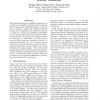Free Online Productivity Tools
i2Speak
i2Symbol
i2OCR
iTex2Img
iWeb2Print
iWeb2Shot
i2Type
iPdf2Split
iPdf2Merge
i2Bopomofo
i2Arabic
i2Style
i2Image
i2PDF
iLatex2Rtf
Sci2ools
COLING
2000
2000
Structural Feature Selection For English-Korean Statistical Machine Translation
When aligning texts in very different languages such as Korean and English, structural features beyond word or phrase give useful intbrmation. In this paper, we present a method for selecting struetm'al features of two languages, from which we construct a model that assigns the conditional probabilities to corresponding tag sequences in bilingual EnglishKorean corpora. For tag sequence mapl)ing 1)etween two langauges, we first, define a structural feature fllnction which represents statistical prol)erties of elnpirical distribution of a set of training samples. The system, based on maximmn entrol)y coneet)t, sele(:ts only ti;atures that pro(luee high increases in loglikelihood of training salnl)les. These structurally mat)ped features are more informative knowledge for statistical machine translation t)etween English and Korean. Also, the inforum.tion can help to reduce the 1)arameter sl)ace of statisti('al alignment 1)yeliminating synta(:tically uiflikely alignmenls.
Related Content
| Added | 01 Nov 2010 |
| Updated | 01 Nov 2010 |
| Type | Conference |
| Year | 2000 |
| Where | COLING |
| Authors | Seonho Kim, Juntae Yoon, Mansuk Song |
Comments (0)

